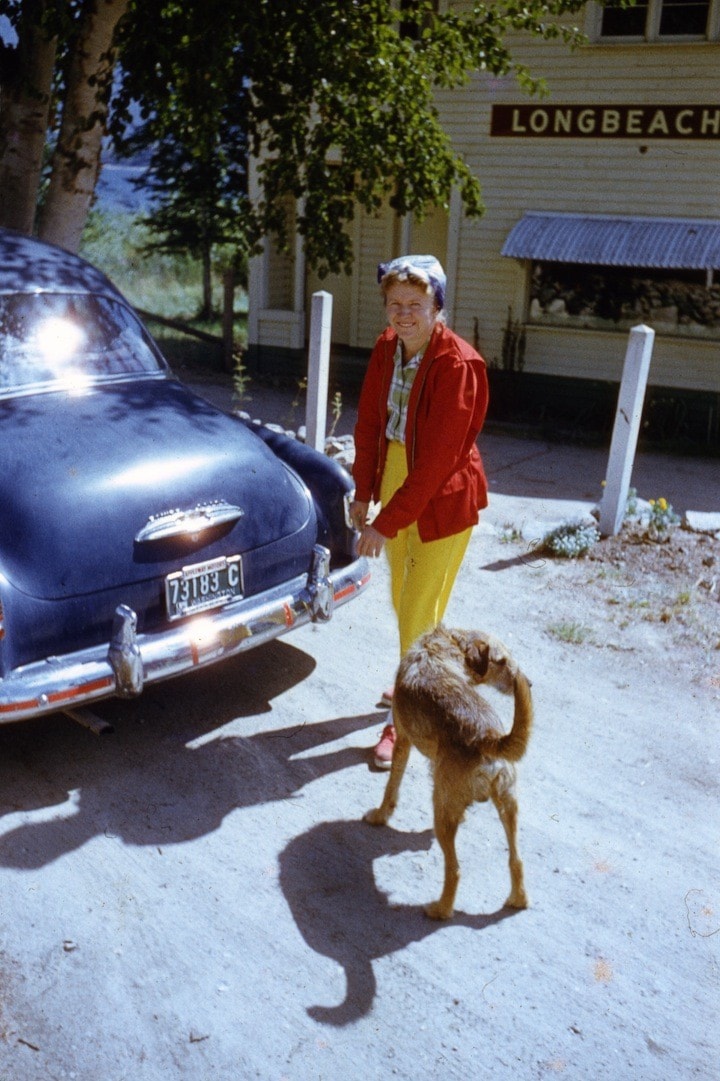One hundred and tenth in a semi-alphabetical series on West Kootenay/Boundary place names
Longbeach, on Kootenay Lake’s West Arm, was formerly called 13 Mile and Halletts Landing. The latter name was after Commander Gordon Hallett (1878-1925), one of several British naval officers who settled there beginning in 1905.
According to Kootenay Outlet Reflections, “Hallett developed a fine orchard. However he was recalled to duty during World War I. Seriously injured in naval action, he was thereafter in chronically poor health as he struggled to work his property. After his death his widow, Edith, managed the property successfully for many years.”
Hallett’s ranch is first mentioned in the Nelson Daily News of May 9, 1906, while the earliest mention of his landing is in the Daily News of Sept. 3, 1913: “Mr. Green said that a floating wharf would shortly be put in at Halletts Landing.”
Edith Winifred Smith wrote in 1962 that “Up to 1914 what is now known as Longbeach was known as 13 Mile, but when the first government wharf was built at Halletts Landing, they told us to choose a name [as] all private landings were to be given up.”
The Daily News of Nov. 25, 1913 reported: “On Monday evening last there was a meeting of the local ranchers at the residence of the Stratton brothers … It was decided a name must be found for the settlement (13 Mile) and three were at last decided on to be sent up to the CPR for their choice of one of them. The names selected were Longbeach, Cottonwood Point, and Connaught Bay.”
The paper added on Feb. 25, 1914: “The name of Longbeach was the one chosen by the Canadian Pacific Railway for this settlement instead of 13 Mile and when the shed on the new government wharf is built the name will be painted upon it.”
Winifred Smith in fact suggested the winning name. Her husband, Commodore Burrard A. Smith, was another British naval officer who settled there. Their son Eric, 97, lives in Nelson with Greta, his wife of 71 years.
LABARTHE
This stop on the Columbia and Western Railway west of Castlegar was originally known as Material Yard, and was first mentioned in the Nelson Tribune of March 27, 1900.
 Eventually the Canadian Pacific Railway came up with a less generic name, as reported by the Greenwood Ledge on Dec. 10, 1908: “The station heretofore known as Material Yard, being the second station west of Castlegar Junction, on the Boundary run, has been rechristened and will in future be called Labarthe. The new name was bestowed in honour of Jules Labarthe, manager of the Trail smelter.”
Eventually the Canadian Pacific Railway came up with a less generic name, as reported by the Greenwood Ledge on Dec. 10, 1908: “The station heretofore known as Material Yard, being the second station west of Castlegar Junction, on the Boundary run, has been rechristened and will in future be called Labarthe. The new name was bestowed in honour of Jules Labarthe, manager of the Trail smelter.”
Jules Labarthe (1874-1951) was born in Peoria, Ill. and studied metallurgy and chemistry at the University of Utah. According to a 1925 profile in the Engineering and Mining Journal (the picture at left comes from that magazine) he came to Trail in 1897 to work as an assayer and draftsman at the smelter, where he prepared plans for the lead blast furnace.
He was promoted to assistant superintendent, then superintendent of the smelter and refinery, and finally in 1906 became general manager.
He left in 1910 to take a similar position with Mason Valley Mines Co. in Nevada and later worked in Kellogg, Idaho, Chewelah, Wash., and Superior, Ariz.
Some sources claim Labarthe was also a construction engineer on the railway that later used his name for a siding, but his biography didn’t mention it.
LAFFERTY
This is another stop on the Columbia and Western Railway, a few kilometers east of Christina Lake.
According to Roger Burrows in Railway Mileposts Vol. II, it was “originally named Wade and renamed for a Rossland bank manager.”
That would be Guy Alexander Lafferty (1879-1934), who in 1912 succeeded J.S.C. Fraser at manager of the Bank of Montreal in Rossland. He did a turn as president of the Winter Carnival and owned some mining claims prior to departing about 1920.
How did his name get attached to a railway siding? Lafferty’s father, Dr. James Delamare Lafferty (1849-1920), was the Canadian Pacific Railway’s chief western surgeon and mayor of Calgary in 1890-91. The name probably honoured the doctor more than his son.
The name survives in Lafferty Pit Road.
The earlier name might have been after CPR roadmaster Philip Wade (1865-1931), who came to Nelson from Ontario in 1902.
Previous installments in this series
Applegrove, Appleby, and Appledale revisited
Bakers, Birds, and Bosun Landing
Bannock City, Basin City, and Bear Lake City
Bealby Point (aka Florence Park) revisited
Boswell, Bosworth, Boulder Mill, and Broadwater
Brooklyn, Brouse, and Burnt Flat
Camborne, Cariboo City, and Carrolls Landing
Carmi, Cedar Point, Circle City, and Clark’s Camp
Carson, Carstens, and Cascade City
Christina City and Christian Valley
Cody and Champion Creek revisited
Champion Creek revisited, again
Columbia City, Columbia Gardens, and Columbia Park
Crawford Bay and Comaplix revisited
Dawson, Deadwood, and Deanshaven
English Cove and English Point
Forslund, Fosthall, and Fairview
Fort Shepherd vs. Fort Sheppard, Part 1
Fort Shepherd vs. Fort Sheppard, Part 2
Gladstone and Gerrard, revisited
Granite Siding and Granite City
Hall Siding and Healy’s Landing
Hudu Valley, Huntingtdon, and Healy’s Landing revisited
Inonoaklin Valley (aka Fire Valley)
Jersey, Johnsons Landing, and Jubilee Point
